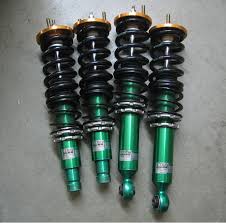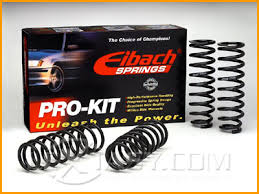Coilovers vs Lowering Springs
#1
Thread Starter
Audi Forum - Posts like an HORCH
Joined: Dec 2009
Posts: 2,719
From: Burlington, Ontario

Coil Overs Vs. Lowering Springs
By William Zane, eHow Contributor
updated: September 11, 2009
I want to do this! What's This?
There are two ways to lower a car that uses coil springs in its suspension. One method is to install stiffer and lower springs, referred to commonly as lowering springs. There are multiple options available for most car makes that have varying degrees of stiffness and how far they lower the car. The other method is to install a coilover suspension, which replaces not just the spring but the shock as well. When done properly, either method will result in a car that handles better and is more responsive to driver input.
Lowering Springs
1. Lowering springs is by far the most common method of lowering a particular car. Lowering springs come in a variety of stiffness and ride height, from stock weight but lower to stiff while still staying near the factory ride height. To install lowering springs, the stock springs are simply removed and replaced by the lower springs.
Advantages and Disadvantages
2. One advantage of this method is the relatively cheap cost. Depending on the brand and what car they are intended for, a set of lowering springs can run anywhere from just over $100 to $500 or more. A limitation of lowering springs is that there is no way to adjust the ride height or the stiffness of them. The only way to change these settings is to install a new set of springs. It also should be noted that when stiffer, lower springs are installed, performance shocks should also be installed to take full advantage of the springs. Sometimes performance shocks must be installed with lowering springs.
Coilovers
3. The term coilover is short for a coil-over-shock setup, where the coil spring is installed around the shock. Coilovers were originally designed for race cars so that the suspension height and dampening settings could be easily changed. Coilovers are installed as one unit instead of a separate spring and shock setup. Though they may look similar in some ways to a Macpherson strut assembly, which is also a spring and shock assembly, coilovers are far more sophisticated.
The springs in coilovers are normally either a single progressive spring or a multi-spring setup with a primary spring and what is known as a helper spring. The helper spring is much lighter and only comes into play when the suspension is at full droop during aggressive cornering. The helper spring ensures the main spring remains stable.
Advantages and Disadvantages
4. By far, the main benefit of coilovers is the range of adjustment they provide. Coilovers are height adjustable via the spring perches that are threaded onto the shock body. The shocks normally offer a range of adjustability that can include shock compression (the downward stroke) and rebound (the upward stroke of the shock as the suspension unloads) with as many as 15 or more settings for each.
Some coilovers such as Motons feature a remotely mounted reservoir that provides the oil for the shock and also allows easy adjustment without having to jack up the car to access the suspension.
The biggest downside to coilovers is the price, which usually starts at just under $1000 and goes up to over $5000 for some of the higher-end brands.
Misconceptions
5. When coilovers were first becoming popular, they gained a reputation as being stiff and uncompromising for the street. But, as technology has improved, so has the streetability of coilovers. With the right settings dialed in, coilovers are actually sometimes more comfortable than stock suspensions, as high-end kits like the Bilstein PSS9 system have proven.
Read more: Coil Overs Vs. Lowering Springs | eHow.com Coil Overs Vs. Lowering Springs | eHow.com
Coilovers (Typical)

Lowering Spring Kit (Typical)

By William Zane, eHow Contributor
updated: September 11, 2009
I want to do this! What's This?
There are two ways to lower a car that uses coil springs in its suspension. One method is to install stiffer and lower springs, referred to commonly as lowering springs. There are multiple options available for most car makes that have varying degrees of stiffness and how far they lower the car. The other method is to install a coilover suspension, which replaces not just the spring but the shock as well. When done properly, either method will result in a car that handles better and is more responsive to driver input.
Lowering Springs
1. Lowering springs is by far the most common method of lowering a particular car. Lowering springs come in a variety of stiffness and ride height, from stock weight but lower to stiff while still staying near the factory ride height. To install lowering springs, the stock springs are simply removed and replaced by the lower springs.
Advantages and Disadvantages
2. One advantage of this method is the relatively cheap cost. Depending on the brand and what car they are intended for, a set of lowering springs can run anywhere from just over $100 to $500 or more. A limitation of lowering springs is that there is no way to adjust the ride height or the stiffness of them. The only way to change these settings is to install a new set of springs. It also should be noted that when stiffer, lower springs are installed, performance shocks should also be installed to take full advantage of the springs. Sometimes performance shocks must be installed with lowering springs.
Coilovers
3. The term coilover is short for a coil-over-shock setup, where the coil spring is installed around the shock. Coilovers were originally designed for race cars so that the suspension height and dampening settings could be easily changed. Coilovers are installed as one unit instead of a separate spring and shock setup. Though they may look similar in some ways to a Macpherson strut assembly, which is also a spring and shock assembly, coilovers are far more sophisticated.
The springs in coilovers are normally either a single progressive spring or a multi-spring setup with a primary spring and what is known as a helper spring. The helper spring is much lighter and only comes into play when the suspension is at full droop during aggressive cornering. The helper spring ensures the main spring remains stable.
Advantages and Disadvantages
4. By far, the main benefit of coilovers is the range of adjustment they provide. Coilovers are height adjustable via the spring perches that are threaded onto the shock body. The shocks normally offer a range of adjustability that can include shock compression (the downward stroke) and rebound (the upward stroke of the shock as the suspension unloads) with as many as 15 or more settings for each.
Some coilovers such as Motons feature a remotely mounted reservoir that provides the oil for the shock and also allows easy adjustment without having to jack up the car to access the suspension.
The biggest downside to coilovers is the price, which usually starts at just under $1000 and goes up to over $5000 for some of the higher-end brands.
Misconceptions
5. When coilovers were first becoming popular, they gained a reputation as being stiff and uncompromising for the street. But, as technology has improved, so has the streetability of coilovers. With the right settings dialed in, coilovers are actually sometimes more comfortable than stock suspensions, as high-end kits like the Bilstein PSS9 system have proven.
Read more: Coil Overs Vs. Lowering Springs | eHow.com Coil Overs Vs. Lowering Springs | eHow.com
Coilovers (Typical)
Lowering Spring Kit (Typical)
Last edited by mikeh; 10-17-2010 at 12:38 PM.
#2
A couple of clarifications:
- Many coilovers use a linear-rate spring (as opposed to a progressive one); usually units designed more for performance/track.
- A helper spring does keep the main spring seated at full-suspension extension, but some multi-spring setups have a tender spring (in place of a helper spring), which is for absorbing light bumps.
- Some additional benefits of coilovers include: the height adjustibility allows you to raise the car up to stock ride height, in some cases even higher, for Winter. Also, contrary to common belief, most suspensions have very undesirable dynamics when lowered more than a small amount (1"-2"). This means many spring/damper kits with non-adjustable height lower the car to levels which produce detrimental performance. With coilovers, you can set the height at optimal levels.
- While PSS9s can offer some of the milder rides for coilovers, they are definitely not high-end, more like mid-end.
I'd also like to note that, after seeing actual shock-dyno results, people would be surprised at how many 'reputable' companies just slap together seemingly untested spring/damper combos which perform rather poorly. This is more prevalent for spring kits, but also occurs in the coilover world.
- Many coilovers use a linear-rate spring (as opposed to a progressive one); usually units designed more for performance/track.
- A helper spring does keep the main spring seated at full-suspension extension, but some multi-spring setups have a tender spring (in place of a helper spring), which is for absorbing light bumps.
- Some additional benefits of coilovers include: the height adjustibility allows you to raise the car up to stock ride height, in some cases even higher, for Winter. Also, contrary to common belief, most suspensions have very undesirable dynamics when lowered more than a small amount (1"-2"). This means many spring/damper kits with non-adjustable height lower the car to levels which produce detrimental performance. With coilovers, you can set the height at optimal levels.
- While PSS9s can offer some of the milder rides for coilovers, they are definitely not high-end, more like mid-end.
I'd also like to note that, after seeing actual shock-dyno results, people would be surprised at how many 'reputable' companies just slap together seemingly untested spring/damper combos which perform rather poorly. This is more prevalent for spring kits, but also occurs in the coilover world.
#3
good info to know. mine are lowered with the eibach springs right now and going to do the coilovers in the spring to adjust the ride height a little. rides a little to low right now with my summer rims.
#7
Poor
Vmaxx
ST Suspensions
Weitec
Cup-kits from any of the members of the Medium/Good group.
Medium/Good
Bilstein
Koni
H&R
Eibach
KW
Excellent
Moton
Stasis Motorsport
KW Clubsport
#10
I'm going to assume (possibly in error) that the stiffness of the spring isn't necessarily proportionate to its quality. I would imagine that stiffness is something that one can choose (by choosing a stiffer or softer product in a product line) and that quality is more dependent on fitment, longevity, proper geometric design, overall handling feel and ability, etc.
Is this not the case? Wouldn't a high end company make products that go from relatively soft to quite stiff to cater to a larger market? Some people might want better suspension without compromising ride quality.
Or am I completely off base here?
Is this not the case? Wouldn't a high end company make products that go from relatively soft to quite stiff to cater to a larger market? Some people might want better suspension without compromising ride quality.
Or am I completely off base here?










